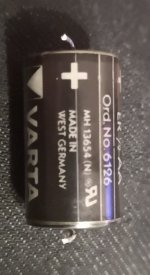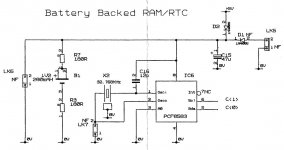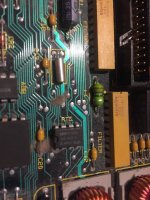-
Updated 2023-07-12: Hello, Guest! Welcome back, and be sure to check out this follow-up post about our outage a week or so ago.
You are using an out of date browser. It may not display this or other websites correctly.
You should upgrade or use an alternative browser.
You should upgrade or use an alternative browser.
Reverse Engineering the Macintosh SE PCB & Custom Chips for 1:1 reproduction
- Thread starter Kai Robinson
- Start date
quorten
Well-known member
If the batteries are really as defective as we may believe, they would have self-discharged to 10% or less of original capacity in 35 years.The batteries in and of themselves do not seem to explode, it's that they explode when depleted.
Phipli
Well-known member
The original SE soldered axial batteries often do well compared to batteries in other Macs. I checked one and it was almost 3v after 31 years.
Why use a NOS battery when you can buy a New battery? This is the same brand as the original.
https://www.ebay.co.uk/itm/262860459865
Or get a socket and put in a removable one.
Question : the Soldered SE batteries are labeled 3v. Can you fit a 3.6v without causing harm? With my SE I fitted a socket but went to the trouble of buying a 3v version.
https://www.ebay.co.uk/itm/280394202604
Why use a NOS battery when you can buy a New battery? This is the same brand as the original.
https://www.ebay.co.uk/itm/262860459865
Or get a socket and put in a removable one.
Question : the Soldered SE batteries are labeled 3v. Can you fit a 3.6v without causing harm? With my SE I fitted a socket but went to the trouble of buying a 3v version.
https://www.ebay.co.uk/itm/280394202604
cheesestraws
Well-known member
I think the last round of components for this have arrived now! IC sockets and some more capacitors. So I'm going to try to get the other half of the soldering done soon...
Kai Robinson
Well-known member
cheesestraws
Well-known member
I will post some  my workbench is currently full of floppy drives and oscilloscope probes (urgh) but when I've finished measuring exactly how depressingly broken this thing is then I'll get onto it...
my workbench is currently full of floppy drives and oscilloscope probes (urgh) but when I've finished measuring exactly how depressingly broken this thing is then I'll get onto it...
quorten
Well-known member
Yes, when powered on, the RTC circuit is actually fed with 5V power, 3.6V will work perfectly fine.Question : the Soldered SE batteries are labeled 3v. Can you fit a 3.6v without causing harm? With my SE I fitted a socket but went to the trouble of buying a 3v version.
Also, nice that you've found the Lithium Manganese Dioxide cells! Now I've looked at the photos in detail of the original VARTA battery I removed, indeed I see the original just says "3V". If indeed the original was also Lithium Manganese Dioxide chemistry, that's pretty nice! My particular copy dropped down to 0.98V in 2019, though, so this is definitely a "your mileage may vary" thing. Lithium Thionyl Chloride batteries are at 3.6V, those are the ones that are used because they are touted as having a very low self-discharge... but when they do discharge completely, they don't merely leak, they explode.
UPDATE: The original battery is labeled with "ER 1/2 AA Order Number 6126", which indicates Lithium Thionyl Chloride chemistry, looks like "3V" was merely an abbreviation of the true nominal voltage of 3.6V. This is the closest product number datasheet I could find.
http://products.varta-microbattery.com/applications/mb_data/documents/data_sheets/DS7126.pdf
My particular copy was lot number 0387... appears to be a code for date of manufacture March 1987.
Last edited by a moderator:
Phipli
Well-known member
Still have the original, let me know if you are interested in more photos - under "Ord. No. 6126" it says "MH 13654 (N)" - I think that means it is Manganese Dioxide? Mine is date code 0188.Also, nice that you've found the Lithium Manganese Dioxide cells! Now I've looked at the photos in detail of the original VARTA battery I removed, indeed I see the original just says "3V". If indeed the original was also Lithium Manganese Dioxide chemistry, that's pretty nice!
...
UPDATE: The original battery is labeled with "ER 1/2 AA Order Number 6126", which indicates Lithium Thionyl Chloride chemistry, looks like "3V" was merely an abbreviation of the true nominal voltage of 3.6V. This is the closest product number datasheet I could find.
http://products.varta-microbattery.com/applications/mb_data/documents/data_sheets/DS7126.pdf
My particular copy was lot number 0387... appears to be a code for date of manufacture March 1987.
http://www.mercateo.co.uk/p/4888-6681/Varta_CR1_2AA_Lithium_battery_6127_UL_MH_13654_N_950mAh.html

quorten
Well-known member
Kai Robinson
Well-known member
@quorten I think i might have found the RTC that's used: https://www.silicon-ark.co.uk/datasheets/pcf8583-datasheet-nxp.pdf
The pinout needs re-jigging, but it's used in a lot of other period correct machines (Acorn A3000 series), would it be worth getting a few? A simple PCB adapter is doable.
The pinout needs re-jigging, but it's used in a lot of other period correct machines (Acorn A3000 series), would it be worth getting a few? A simple PCB adapter is doable.
davidg5678
Well-known member
I think so! I think it would be nice to be able to build these new boards with as many or few original parts as possible.would it be worth getting a few?
Kai Robinson
Well-known member
Ordered 10 to start with.
cheesestraws
Well-known member
The pinout needs re-jigging, but it's used in a lot of other period correct machines (Acorn A3000 series), would it be worth getting a few? A simple PCB adapter is doable.
They seem to be pretty reliable long-haul in the Acorns - at least, I've only had to replace one of them, and I think that was probably invisible battery leak damage rather than anything else. So probably a good option here, too...
Kai Robinson
Well-known member
quorten
Well-known member
@Kai Robinson The NXP chip definitely has a different software interface than Apple's custom silicon. I'd say the chips definitely look handy for use in other projects (like a Raspberry Pi RTC), but ROM patches would be required to use it for Macintosh computers.
One good note, looks like the Acorn schematic is wired up expecting the same load capacitance from the crystal, but the Apple way of using a 10pF and 33pF capacitor together is probably cheaper than using a single 12pF capacitor due to specialized component costs.
One good note, looks like the Acorn schematic is wired up expecting the same load capacitance from the crystal, but the Apple way of using a 10pF and 33pF capacitor together is probably cheaper than using a single 12pF capacitor due to specialized component costs.
cheesestraws
Well-known member
Phipli
Well-known member
Can someone sanity-check me here please? L1 on the BoM is marked as 33 µH, but on the board I am taking bits off, it seems to be 21 µF (apologies for poor colour reproduction)
View attachment 38733

cheesestraws
Well-known member
Thankyou!
Phipli
Well-known member
Although in my photo it looks more like 27 or 28? Doesn't look brown...Thankyou!
Edit : looking again it could be. Sigh, you'd think it would be easier to tell!
Last edited by a moderator:
Similar threads
- Replies
- 39
- Views
- 5K
- Replies
- 23
- Views
- 2K
- Replies
- 5
- Views
- 708



